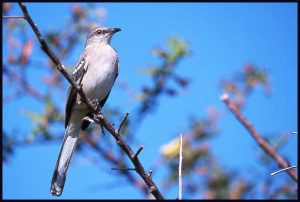Normally I would begin a series like this with an introduction to local wildlife and not a specific topic. However, I have – in the last few days – witnessed several cases of territoriality in my backyard and think this may be a good time to do this lesson… I think everyone will probably witness this when they venture into their yards during this down time as well.

Photo: Rick O’Connor
Let’s first begin with what territoriality is all about.
It is a behavior found in many vertebrates where they mark and defend an area we call their territory.
Why do they do this?
Well… first, it is usually the males of the species who do.
Second, there are primarily three reasons why they do – (1) to defend an area of food… (2) to defend a popular nesting area, and so win the heart of the female(s)… (3) to defend their females from other intruding males.
The behavior goes through a series of steps.
Step 1 – Mark Your Territory
If you are the resident male with a territory, you will mark the area in some form or fashion. Some species do so with a visual clue – such as bears scratching the side of a tree. Others use chemical clues – such as deer spraying musk on trees. However they do it, the territory is marked. The size of the territory will vary and is based on what area a male can defend. Some males are strong enough to defend a territory that includes multiple nests and multiple females.
Step 2 – Make Your Self Look Larger Than You Are
If a male chooses to challenge the resident male, they will cross the territorial marker. The resident male typically responds by making himself look bigger than he really is. Fish will expand their gill plates and extend their fins vertically and horizontally, snakes will “puff up” or lie flat to make themselves look wider and larger, squirrels will sit upright with their tails extended vertically above their heads and usually vibrate them, dogs will raise their ears and tails as well as the fur on the back of their necks. There are numerous methods of doing this you can view in the yard. If the challenger is not intimidated with this and remains… we move to step 3.
Step 3 – Display the Weapon You Will Use
If the challenger does not back down and, rather, shows how big he is in response the next step is to display the weapon they will use if an encounter happens. Some fish will expose sharp spines and snap their jaws, some snakes will open their mouths to display teeth, cats and dogs also show their teeth and/or claws. If the challenger is still not intimidated, we will have to move to step 4.
Step 4 – Fight
If we reach this step most fights are over in just a few seconds to minutes. Watching squirrels and birds I would say in seconds. Bighorn sheep, who use their large horns in battles, can go on for several minutes before a winner is decided. Not only do most fights end quickly it is very rare that anyone is hurt, much less dies. However, in some species – long battles have caused wounds that can be life threatening. Elephant seals on the west coast of the United States are known to fight long bloody battles. Gopher tortoises are known to flip their competitors over on their backs, sometimes not being able to right themselves.

Photo: University of Florida
In 90+% of the cases, territorial behavior is between males of the same species – since they want the same thing. However, at times some species feel threatened by other species besides their own. Gray triggerfish, blennies, and mockingbirds are aggressive to any would be intruder.
ACITIVITY
Recently I observed both gray squirrels and songbirds fighting from my back porch. There were three different grays squirrels chasing each other between two trees and the power line between two poles – all focused on one oak tree. I was unable to determine which of the three were there first and the resident champ, but it was easy to determine which was the winner… he went back to the nest as the victor and the others moved to new trees.
I also watched a mockingbird chase off cardinals, wrens, and other songbirds who were getting too close to where its nest was (in a boxwood in my yard).
You may also witness mockingbirds and crows attack hawks who are too close for comfort. Green anoles (common green lizard) will bob his head and expand his orange dewlap before commencing into battle with a rival lizard.
I have found the best time to witness this is in the morning hours. When you are finished reading this, have a good breakfast and then set up on the porch with a camera and binoculars and see what happens.
Bird feeders are always places of conflict and you should be able to tell who is the stronger of your backyard wildlife friends.
Have fun and let me know what you see. Video if you can!
 0
0
